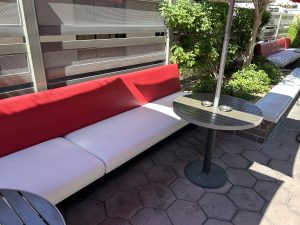


Stylized Fall: Colors and Shapes in Harmon 2023

Reupholstery has grown increasingly popular in recent years as more people seek to breathe new life into their favorite furniture. Interest in reupholstery also stems from a growing appreciation for sustainability, craftsmanship, and the charm of well-made furniture.
In an era of mass-produced items, reupholstery offers a way to preserve quality and create personalized home decor.
If you’re looking for information about reupholstery, you’ve come to the right place. This article aims to demystify the process of reupholstery, explaining what it entails and helping you determine when it’s the right choice for your furniture.
Whether you’re looking to customize your furniture, update a family heirloom, or make an eco-friendly choice, understanding reupholstery can open up a world of possibilities for your home.
Reupholstery Defined: Reupholstery includes replacing old fabric, padding, and other materials to restore or enhance a piece of furniture’s comfort, appearance, and functionality.
Understanding Upholstery’s History: Upholstery evolved from the use of natural materials in the Middle Ages to modern fabrics, foams, and metal springs that offer durability and a wide range of design options.
Reupholstery vs. Restoration: Reupholstery updates the look and feel of furniture by replacing materials. Restoration, meanwhile, focuses on maintaining the piece’s original character and materials.
Choosing Reupholstery: Reupholstery is ideal for several reasons, such as when you want to preserve a high-quality frame, customize your furniture, save a family heirloom, or make an environmentally conscious choice.
Eco-Friendly Benefits: Reupholstery reduces waste, minimizes your carbon footprint, and conserves resources, making it a sustainable alternative to purchasing new furniture.
Customization Opportunities: Reupholstery allows for tailored design choices, including fabric, padding, trim, and structural changes.
Evaluating Furniture for Reupholstery: To determine if reupholstery is a smart investment, buyers must consider factors like the furniture’s age, sturdiness, frame quality, and sentimental value.
Balancing Cost and Sentiment: While reupholstering can be as costly as buying new, the value of a cherished piece of furniture can make it a worthwhile investment.
When to Buy New: It might be better to consider a new purchase if the cost of reupholstery is similar to buying new and the piece lacks quality or sentimental value.
Why Choose Redesign Upholstery: Our company, Redesign Upholstery, takes a fully custom approach. We work closely with you, the client, to create one-of-a-kind pieces that meet your unique needs.
Answer: Reupholstery is the process of revitalizing furniture by replacing old upholstery. This process is quite comprehensive and requires several steps, which include: Stripping away the old fabric and padding, repairing or replacing internal components as needed, applying new padding and cushioning materials, and covering the piece with fresh fabric.
The result is a better-looking, more comfortable, and more functional piece of furniture. This process not only breathes new life into furniture but also allows for customization to suit current tastes and decor.
The Evolution of Upholstery
To fully understand how reupholstery works, it’s helpful to look at the evolution of upholstery itself.
Upholstery has roots dating back to the Middle Ages. However, it gained popularity during the 17th and 19th centuries, during which time materials like horsehair, grass, feathers, and animal hair were commonly used for stuffing. Meanwhile, wealthy patrons requested luxurious fabrics such as velvet, silk, and needlework for coverings.
Today’s reupholstery benefits from modern materials like durable metal springs and foam, along with a vast array of fabric options to suit contemporary tastes and needs.
To dispel confusion, we want to clarify that reupholstery and restoration are very different processes that have distinct goals.
Reupholstery aims to update a piece of furniture’s look and feel. For instance, you might reupholster an outdated armchair with new trendy fabric and fresh foam cushions to make it fit a more contemporary style.
Restoration, on the other hand, focuses on preserving the original character of furniture. A restoration project might involve carefully repairing the original fabric of an antique sofa or replacing worn-out horsehair stuffing with similar materials to maintain an authentic feel.
In other words, reupholstery requires the replacement of the fabric and materials, while restoration aims to keep the piece as close to its original state as possible.
Choosing Between Reupholstery and Restoration
The choice between reupholstery and restoration depends on the furniture’s value and the owner’s goals. Restoration is better suited for valuable antiques where preserving original materials is crucial.
Reupholstery is a fantastic and popular way to transform your furniture, but it’s not always the best choice. Before deciding to reupholster, take a moment to think about what you want.
Question: Are you hoping to preserve a sentimental item, improve your home’s interior, or simply repair a piece of furniture damaged from years of use?
Clarifying your goals and needs will help you determine whether reupholstery is the right path. That said, let’s explore some possibilities and what might make it the perfect choice for you.
Reupholstery is an excellent option when you have a piece of furniture with a high-quality, sturdy frame that’s worth preserving. Many older pieces, for instance, feature durable wood framing that is valuable and costly to recreate today.
If your furniture has a solid hardwood frame or is notably heavy, it’s probably well-constructed and an ideal candidate for reupholstering.
If you’re looking to create a unique piece that reflects your personal style, reupholstery is an ideal choice. Customizing your furniture through reupholstery allows you to select from various fabrics, colors, textures, and finishes, transforming your piece into something that perfectly suits your aesthetic preferences.
You can modify aspects like cushion firmness, padding thickness, arm and back styles, and even the overall shape to fit your space better. This level of customization is impossible with mass-produced furniture. Reupholstery gives you much greater control over the final product’s look and feel.
Reupholstery is a great option if you want to breathe new life into an heirloom piece or antique.
Again, reupholstery offers you incredible flexibility to suit your needs.
Reupholstering your furniture is a great choice for reducing your environmental footprint because it requires fewer resources than manufacturing new furniture….And, when you revitalize an existing piece with a high-quality frame, you preserve the craftsmanship of well-made furniture.
Keeping high-quality frames out of landfills is a good thing!
Reupholstery offers benefits that extend beyond outer aesthetics. While it greatly improves the look of your furniture, the materials and craftsmanship involved in reupholstery surpass those of new, mid-range furniture, leading to greater comfort and durability.
Deciding whether to reupholster a piece of furniture can be challenging, but it comes down to understanding the value it brings to your home.
To make the right choice, ask yourself the following questions.
When considering a piece for reupholstery, age is a key factor. Furniture made in the last decade may not be built for longevity and often isn’t worth reupholstering. Older furniture, especially anything over 10 years old, tends to feature higher-quality materials and craftsmanship.
A piece that has remained structurally sound after 10 to 15 years of use is likely an excellent candidate for reupholstery, having already demonstrated its durability.
A strong candidate for reupholstery is a piece that is solid and well-built. To evaluate sturdiness, firmly shake the furniture by its arms and back.
If it remains stable, it’s likely worth reupholstering. However, you should probably avoid investing in reupholstery if the piece wobbles or feels unstable during this test.
To assess the quality of a frame, remove the cushions and lift the piece. A heavier weight for its size typically suggests a robust frame. The ideal frame should be hardwood with minimal knots, featuring joints reinforced with dowels and glue rather than staples.
Note: If the sofa is light, it might indicate wood that’s not strong enough to warrant reupholstering. When in doubt about the frame, use the material, weight, and construction as clues to guide your final decision.
Did you know an upholsterer can often work with existing material if the padding feels firm or has some lumps? To assess this, squeeze the padded areas of the arms and back and press down on the cushions.
However, if these areas compress easily or feel overly soft, it likely indicates low-quality foam. In such cases, reupholstery may be a less worthwhile option, as the underlying structure might not support long-term use and comfort.
Before deciding on reupholstery, consider how long you plan to keep the piece. Are you likely to move or redecorate, or do you envision this piece staying in your home for years?
Also, assess the furniture’s condition—are only the fabric and padding worn, or are there structural issues as well?
This will help determine if the investment is worthwhile.
Answer: Yes, if the answer is 5 or 6 years. In this case, reupholstering is almost certainly the way to go.
As a client, you want to think about how much a piece of furniture means to you when deciding whether to reupholster.
After all, sometimes the memories tied to a piece make it more valuable than its price tag suggests. You get to keep something special while updating it for your space.
The cost-sentiment equation is an important one.
A skilled upholsterer will likely charge you as much for reupholstery as you would pay for a new piece of furniture. So, the true reason to get reupholstery is often sentimental.
If you don’t love the unique style or design of the piece, have no fond memories associated with it, or don’t want to preserve a family heirloom….Or, if the quality of the materials isn’t that good, then buying new is probably a better choice.
At Redesign Upholstery, we love hearing your ideas and turning them into reality, whether it’s crafting a custom design for a new restaurant or transforming a guest bedroom with a fresh look. No request is too unusual or specific for us—we welcome the challenge of specialty projects and bringing them to life.
Our custom approach means we have the skills and expertise to engineer your vision into a truly one-of-a-kind piece. We’ll work closely with you to select the perfect fabrics and features for your project.
When your furniture arrives at our workshop, we meticulously remove the old fabric and inspect the furniture’s structure for any necessary repairs. If any extensive repairs are needed, we’ll let you know immediately. Once ready, we will complete the reupholstery with your chosen materials.
Want to know more? Visit Redesign Upholstery’s Home page to learn more about us and get started.


